Vicksburg, Mississippi 作者: 来源: 发布时间:2021-11-09
I.Population and Area
₋Area
Land: 33.01 sq mi (85.50 km2)
₋Population
Total: 23,856
Density: 655.89/sq mi (253.24/km2)

II.Natural Geography
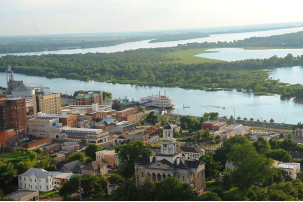
City View
₋Vicksburg is a historic American city, located on a high bluff on the east bank of the Mississippi River across from Louisiana.
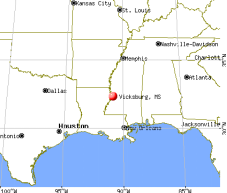
₋Originally built by French colonists in 1719, the outpost withstood an attack from the native Natchez people. It was incorporated as Vicksburg in 1825 after Methodist missionary Newitt Vick. In the American Civ il War, it was a key Confederate river-port, and its surrender to Ulysses S. Grant in July 1863 marked the turning-point of the war. Vicksburg then had a troubled history of racial conflict, well into the 20th century. The city is home to three large installations of the US Army Corps of Engineers, which has often been involved in local flood control.
₋Vicksburg is the county seat of Warren County, Mississippi, with a population of 23,856 at the 2010 census.
III.ECONOMY
₋As of the census of 2000, 26,407 people, 10,364 households, and 6,612 families resided in the city, with a metropolitan population of 49,644. The population density was 803.1 people per square mile (310.1/km²). The 11,654 housing units averaged 354.4 per square mile (136.9/km²). The racial makeup of the city was 60.43% African American, 37.80% White, 0.15% Native American, 0.61% Asian, 0.43% from other races, and 0.59% from two or more races. Hispanics or Latinos of any race were 1.04% of the population.
₋Of the 10,364 households, 32.2% had children under the age of 18 living with them, 34.9% were married couples living together, 24.2% had a female householder with no husband present, and 36.2% were not families. About 32.0% of all households were made up of individuals, and 13.6% had someone living alone who was 65 years of age or older. The average household size was 2.49 and the average family size was 3.15.
₋In the city, the population was distributed as 28.4% under the age of 18, 9.3% from 18 to 24, 27.9% from 25 to 44, 19.6% from 45 to 64, and 14.8% who were 65 years of age or older. The median age was 34 years. For every 100 females, there were 82.9 males. For every 100 females age 18 and over, there were 77.3 males.
₋The median income for a household in the city was $28,466, and for a family was $34,380. Males had a median income of $29,420 versus $20,728 for females. The per capita income for the city was $16,174. About 19.3% of families and 23.0% of the population were below the poverty line, including 34.8% of those under age 18 and 16.5% of those age 65 or over.
IV.Industrial Characteristics
₋For the Warren County Port Commission, it’s a success story that stretches back more than 50 years to the founding of the port in 1968. But Vicksburg’s maritime roots go back much farther than that.
₋“Vicksburg’s beginnings and its entire history are tied to the river,” Diaz said. “A historical river city, Vicksburg once became the richest and most celebrated city in the state of Mississippi. Its river made the city a protagonist of one of the decisive battles of the American Civil War, and since then, its economy, its culture and its people have continued to evolve along with its river.”
₋During the Civil War, both Confederate and Union leaders saw Vicksburg as, in President Abraham Lincoln’s words, “the key.” Confederate President Jefferson Davis reportedly called Vickszurg “the nailhead that held the South’s two halves together.”
₋At the time of the Civil War, Vicksburg was located at the lower end of a dramatic 180-degree bend on the Mississippi River. The city was well-fortified and well-armed, which made it difficult and dangerous for Union forces seeking to move troops and supplies by river below the city. Union Gen. Ulysses S. Grant actually envisioned digging a canal on the river to bypass the city. Instead, it was Union naval commander David Dixon Porter who would move enough supplies past Vicksburg in April 1863, which set the stage for the siege and battle later that spring and summer. Confederate forces finally surrendered on July 4, 1863.
₋And while Grant’s bypass canal never came to fruition, the Mississippi River dramatically changed course just 13 years later on April 26, 1876. The city, first settled in 1719 and incorporated as “Vicksburg” in 1825, named for Methodist missionary Newitt Vick, had been, in a day, cut off from the river that had made it so strategic.
₋But that isolation from the river was only temporary. In 1878, just two years after the course change, the Corps of Engineers began work on the Yazoo River Diversion Canal. The project called for changing the course of the Yazoo River just north of the city. Instead of joining the Mississippi River several miles upriver, the Corps undertook to shift the course of the Yazoo more to the south, with the Yazoo overtaking the oxbow lake formed by the Mississippi River’s course change, then running past Vicksburg and rejoining the Mississippi just below the city.
₋The project took 25 years to complete, and the city of Vicksburg finally regained its connection to the river in 1903.
₋Today, Vicksburg’s connection to the Mississippi River goes well beyond the maritime industry. The city boasts a thriving passenger cruise business, with more than 100 passenger vessels docking at Vicksburg each year. Earlier this year, city officials announced tentative plans to build a cruise vessel terminal to serve Viking River Cruises’ Mississippi River vessels, should those become reality. Though Viking continues to build partnerships to launch a cruise line on the Mississippi River, the company has not announced any specific plans or a timeline.
₋Website: https://www.waterwaysjournal.net/2019/10/04/vicksburg-a-center-for-industry-history-and-tourism/
V.Attractions
1.Vicksburg National Military Park
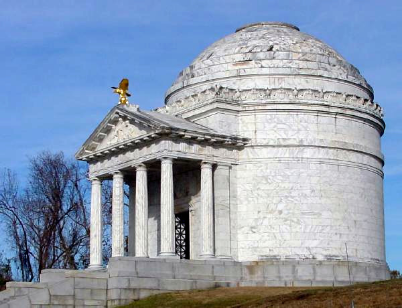
₋Vicksburg National Military Park preserves the site of the American Civil War Battle of Vicksburg, waged from March 29 to July 4, 1863. The park, located in Vicksburg, Mississippi (flanking the Mississippi River), also commemorates the greater Vicksburg Campaign which led up to the battle. Reconstructed forts and trenches evoke memories of the 47-day siege that ended in the surrender of the city. Victory here and at Port Hudson, farther south in Louisiana, gave the Union control of the Mississippi River.
₋The park includes 1,325 historic monuments and markers, 20 miles (32 km) of historic trenches and earthworks, a 16-mile (26 km) tour road, a 12.5-mile (20.1 km) walking trail, two antebellum homes, 144 emplaced cannons, the restored gunboat USS Cairo (sunk on December 12, 1862, on the Yazoo River), and the Grant's Canal site, where the Union Army attempted to build a canal to let their ships bypass Confederate artillery fire.
₋The Cairo, also known as the "Hardluck Ironclad," was the first U.S. ship in history to be sunk by a torpedo/mine. It was recovered from the Yazoo in 1964.
₋The Illinois State Memorial has 47 steps, one for every day Vicksburg was besieged.
₋Address: 3201 Clay St, Vicksburg, MS 39183, United States
₋Phone: +1 601-636-0583
₋Website: https://www.nps.gov/vick/index.htm
2.USS Cairo
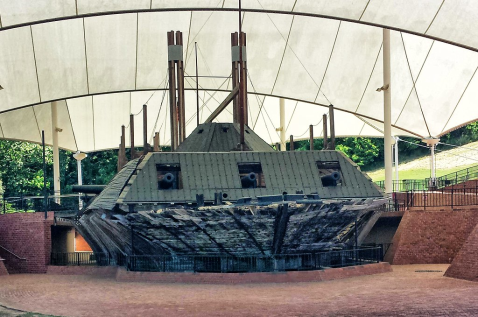
₋USS Cairo was one of the first American ironclad warships built at the beginning of the U.S. Civil War.
₋Cairo was the lead ship of the City-class gunboats and named for Cairo, Illinois. In June 1862, she captured the Confederate garrison of Fort Pillow on the Mississippi, enabling Union forces to occupy Memphis. As part of the Yazoo Pass Expedition, she was sunk on 12 December 1862, while clearing mines for the attack on Haines Bluff. Cairo was the first ship ever to be sunk by a mine remotely detonated by hand.
₋The remains of Cairo can be viewed at Vicksburg National Military Park with a museum of its weapons and naval stores.
₋Cairo was built by James Eads and Co., Mound City, Illinois, in 1861, under contract to the United States Department of War. She was commissioned as part of the Union Army's Western Gunboat Flotilla, which had US Navy Lieutenant James M. Prichett in command.
₋Cairo served with the Army's Western Gunboat Flotilla on the Mississippi and Ohio Rivers, and their tributaries until she was transferred to the Navy on 1 October 1862, with the other river gunboats. She was commanded by Flag Officer Andrew Hull Foote.
₋Active in the occupation of Clarksville, Tennessee, 17 February 1862, and of Nashville, Tennessee, 25 February, Cairo stood down the river on 12 April, escorting mortar boats to begin the lengthy operations against Fort Pillow. An engagement with Confederate gunboats at Plum Point Bend on May 11, marked a series of blockading and bombardment activities which culminated into the abandonment of the fort by its defenders on 4 June.
₋On 6 June 1862, two days later, Cairo joined in the triumph of seven Union ships and a tug over eight Confederate gunboats off Memphis. Five of the opposing gunboats were sunk or run ashore during this action; two were seriously damaged, and one managed to escape. That night, Union forces occupied the city. Cairo returned to patrol on the Mississippi until 21 November, when she joined the Yazoo Pass Expedition.
₋On December 12, 1862, while clearing mines from the river, preparatory to the attack on Haines Bluff, Cairo struck a "torpedo" (or naval mine) detonated by volunteers hidden behind the river bank and sank in 12 minutes. There were no casualties.
₋Address: 3201 Clay St, Vicksburg, MS 39183, United States
₋Length: 53 m
₋Construction started: 1861
₋Launched: 1861
₋Website: https://www.nps.gov/vick/u-s-s-cairo-gunboat.htm
3.McRaven
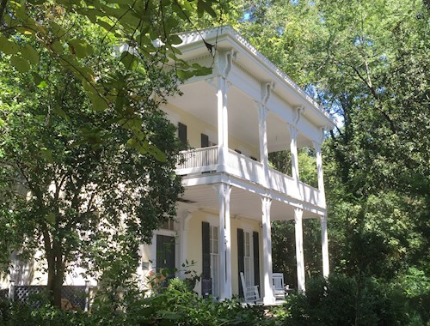
₋McRaven was built ca.1797 by Andrew Glass in a town called Walnut Hills, which is now Vicksburg, Mississippi. In the Civil War era, it was known as the Bobb House, and it is listed on the National Register of Historic Places as such. McRaven got its current name from the street it is located on, which was formerly called McRaven Street, but is now Harrison Street. McRaven has been on the Mississippi Department of Archives and History's Historic Preservation list since January 8, 1978. It is also believed by many to be haunted, and has been called "the most haunted house in Mississippi."
₋The first part of what is now McRaven was built by Andrew Glass ca. 1797 and originally serving as a way station for pioneers en route to Nashville, Tennessee along the Natchez Trace to the Mississippi River. As first built, McRaven consisted of only a kitchen with one room above it, this part of the house is now known as the "Pioneer Section".
₋In 1836, Sheriff Stephen Howard bought the house and added the middle dining room and the bedroom above it, built in Empire architectural style. Sheriff Howard's wife Mary Elizabeth Howard died during childbirth in late August, 1836 in the middle bedroom.
₋The house was purchased by John H. Bobb in 1849, Bobb built the rest of the house in Greek Revival style. During the Civil War's 1863 Siege of Vicksburg, McRaven was used as a Confederate field hospital and camp site. Since it was located so close to the railroad, a major point of battle, the house was battered by cannon blasts from both the Union and Confederate forces. However, it still stands.
₋On May 18, 1864, after Vicksburg had fallen to Union forces, John Bobb noticed a group of six drunken Union occupation soldiers picking flowers from his garden. Outraged, Bobb promptly ordered them to leave immediately, the soldiers cursed at him and refused to leave, so John picked up a brick and threw it at them, knocking a sergeant to the ground. The soldiers left, vowing to burn down Bobb's house. Bobb then reported the incident to the Federal Commander of Vicksburg, Gen. Henry W. Slocum who dismissively said he would admonish those responsible. Upon returning to the gates of his home, Bobb was met by 25 Union troops who took him to Stout's Bayou, about 100 yards from the house, and fatally shot him in the back and face. Bobb's death was the first recorded act of violence perpetrated by Union troops after the Siege. John's widow Selina Bobb sold the house to a realtor in 1869, and moved to a family plantation outside of New Orleans, Louisiana called Sunnyside.
₋McRaven was eventually sold to William Murray in 1882. Murray and his wife Ellen Flynn raised four daughters and three sons in McRaven. William Murray died at the house in 1911, his wife Ellen died there in 1921, their daughter Ida died in 1946, and a son died in 1950, all in McRaven. From this point on, William's daughters Annie and Ella Murray, both unmarried, lived alone in the house with no modern conveniences aside from a telephone, and no contact with the outside world except their doctor, Walter Johnston. In 1960, Ella Murray died at the age of 81, and her sister Annie sold the house after moving to a nursing home. At this point, the house was in such disrepair that neighbors and nearby residents had no idea it existed. The upper story was completely overgrown with vines and the sisters had resorted to chopping up the antique furniture for firewood.
₋In 1960, the house was sold to the Bradway family. With a cosmetic restoration McRaven was opened to the public as a tour home in 1961. In 1979, O.E. Bradway sold McRaven and some of the furnishings to Charles and Sandra Harvey for $75,000. After the spring pilgrimage, the Harvey's closed the house and took on a year long restoration at a cost near $100,000. The restoration included such things as woodwork, rewiring, plumbing and plastering. A master at plaster restorations, Mr. Little of Jackson took on the extraordinary task of plastering all the walls and ceilings and restoring the Greek Revival cornices and ceiling medallions. Having samples of the original carpet from the John Bobb era, Mrs. Harvey found a company in Georgia to reproduce the carpet for the parlor, front entry, stairwell and upstairs front bedroom. She also did extensive research on each period of the house to have authentic paint, wallpaper, fabrics and furnishings for the public. The front and rear porch were in disrepair and had been roped off by Bradway. Lincoln Brown with the Waterways Experimental Station rebuilt both front and rear porches. While in the attic, Mr. Harvey discovered many rafters had been damaged from the Union's shelling and needed repair. The 1840 privy which was purchased by Bradway from the Vick House was also repaired. Once again ready for touring, the Vicksburg Sunday Post featured McRaven's spring pilgrimage open house in their April 6, 1980 issue. McRaven had been returned to her authentic glory. Though the Harvey's and their two children never lived in the house, they spent many nights in the Howard's bedroom protecting the house from vandals. In 1984, The Harvey's moved to Natchez and sold McRaven to Leyland French for $275,000.
₋In 1984, Leyland French purchased McRaven and did further restoration, French was the first owner since the Murrays to reside in the house. Aside from a modern kitchen and bathroom in its basement, McRaven has remained largely unchanged since the 19th century. For this reason, McRaven was featured in the July 1963 issue of National Geographic Magazine which called it the "Time Capsule of the South."
₋In May 2007, owner Leyland French put McRaven up for sale for $1,750,000. In August 2015, Steven and Kendra Reed purchased the home. They reopened it for both historical and ghost tours.
₋Address: 1445 Harrison St, Vicksburg, MS 39180, United States
₋Opened: 1836
₋Phone: +1 601-501-1336
₋Website: https://www.mcraventourhome.com/
VI.History
₋First People
₋The area that is now Vicksburg was long occupied by the Natchez Native Americans as part of their historical territory along the Mississippi. The Natchez spoke a language isolate not related to the Muskogean languages of the other major tribes in the area. Before the Natchez, other indigenous cultures had occupied this strategic area for thousands of years.
₋European settlement
₋The first Europeans who settled the area were French colonists who built Fort Saint Pierre in 1719 on the high bluffs overlooking the Yazoo River at present-day Redwood. They conducted fur trading with the Natchez and others, and started plantations. On 29 November 1729, the Natchez attacked the fort and plantations in and around the present-day city of Natchez. They killed several hundred settlers, including the Jesuit missionary Father Paul Du Poisson. As was the custom, they took a number of women and children as captives, adopting them into their families.
₋The Natchez War was a disaster for French Louisiana, and the colonial population of the Natchez District never recovered. Aided by the Choctaw, traditional enemies of the Natchez, though, the French defeated and scattered the Natchez and their allies, the Yazoo.
₋The Choctaw Nation took over the area by right of conquest and inhabited it for several decades. Under pressure from the US government, the Choctaw agreed to cede nearly 2,000,000 acres (8,100 km2) of land to the US under the terms of the Treaty of Fort Adams in 1801. The treaty was the first of a series that eventually led to the removal of most of the Choctaw to Indian Territory west of the Mississippi River in 1830. Some Choctaw remained in Mississippi, citing article XIV of the Treaty of Dancing Rabbit Creek; they became citizens of the state and the United States. They struggled to maintain their culture against the pressure of the binary slave society, which classified people as only white or black.
₋In 1790, the Spanish founded a military outpost on the site, which they called Fort Nogales (nogales meaning "walnut trees"). When the Americans took possession in 1798 following the American Revolutionary War and a treaty with Spain, they changed the name to Walnut Hills. The small village was incorporated in 1825 as Vicksburg, named after Newitt Vick, a Methodist minister who had established a Protestant mission on the site.
₋In 1835, during the Murrell Excitement, a mob from Vicksburg attempted to expel the gamblers from the city, because the citizens were tired of the rougher element treating the city residents with nothing but contempt. They captured and hanged five gamblers who had shot and killed a local doctor. Historian Joshua D. Rothman calls this event "the deadliest outbreak of extralegal violence in the slave states between the Southampton Insurrection and the Civil War."
₋Civil War
₋During the American Civil War, the city finally surrendered during the Siege of Vicksburg, after which the Union Army gained control of the entire Mississippi River. The 47-day siege was intended to starve the city into submission. Its location atop a high bluff overlooking the Mississippi River proved otherwise impregnable to assault by federal troops. The surrender of Vicksburg by Confederate General John C. Pemberton on July 4, 1863, together with the defeat of General Robert E. Lee at Gettysburg the day before, has historically marked the turning point of the Civil War in the Union's favor.
₋From the surrender of Vicksburg until the end of the war in 1865, the area was under Union military occupation.
₋Because of the city's location on the Mississippi River, it built extensive trade from the prodigious steamboat traffic in the 19th century. It shipped out cotton coming to it from surrounding counties and was a major trading city.
₋In 1876, a Mississippi River flood cut off the large meander flowing past Vicksburg, leaving limited access to the new channel. The city's economy suffered greatly. Between 1881 and 1894, the Anchor Line, a prominent steamboat company on the Mississippi River from 1859 to 1898, operated a steamboat called the City of Vicksburg.
₋Political and racial unrest after Civil War
₋Celebrations of the 4th of July, the day of surrender, were irregular until 1947. The Vicksburg Evening Post of July 4, 1883, called July 4 "the day we don't celebrate", and another Vicksburg newspaper, the Daily Commercial Appeal, in 1888 hoped that a political victory would bring an enthusiastic celebration the following year. In 1902, the 4th of July saw only "a parade of colored draymen". In 1947, the Jackson Clarion-Ledger stated that the city of Vicksburg did not celebrate the 4th of July again until 1945, and then it was celebrated as Confederate Carnival Day. A recent scholar disagrees, stating that large Fourth of July celebrations were being held by 1907, and informal celebrations before that. A large parade was held in 1890.
₋In the first few years after the Civil War, white Confederate veterans developed the Ku Klux Klan, beginning in Tennessee; it had chapters throughout the South and attacked freedmen and their supporters. It was suppressed about 1870. By the mid-1870s, new white paramilitary groups had arisen in the Deep South, including the Red Shirts in Mississippi, as whites struggled to regain political and social power over the black majority. Elections were marked by violence and fraud as white Democrats worked to suppress black Republican voting.
₋In August 1874, a black sheriff, Peter Crosby, was elected in Vicksburg. Letters by a white planter, Batchelor, detail the preparations of whites for what he described as a "race war," including acquisition of the newest guns, Winchester 16 mm. On December 7, 1874, white men disrupted a black Republican meeting celebrating Crosby's victory and held him in custody before running him out of town. He advised blacks from rural areas to return home; along the way, some were attacked by armed whites. During the next several days, armed white mobs swept through black areas, killing other men at home or out in the fields. Sources differ as to total fatalities, with 29–50 blacks and 2 whites reported dead at the time. Twenty-first-century historian Emilye Crosby estimates that 300 blacks were killed in the city and the surrounding area of Claiborne County, Mississippi. The Red Shirts were active in Vicksburg and other Mississippi areas, and black pleas to the federal government for protection were not met.
₋At the request of Republican Governor Adelbert Ames, who had left the state during the violence, President Ulysses S. Grant sent federal troops to Vicksburg in January 1875. In addition, a congressional committee investigated what was called the "Vicksburg Riot" at the time (and reported as the "Vicksburg Massacre" by northern newspapers.) They took testimony from both black and white residents, as reported by the New York Times, but no one was ever prosecuted for the deaths. The Red Shirts and other white insurgents suppressed Republican voting by both whites and blacks; smaller-scale riots were staged in the state up to the 1875 elections, at which time white Democrats regained control of a majority of seats in the state legislature.
₋Under new constitutions, amendments and laws passed between 1890 in Mississippi and 1908 in the remaining southern states, white Democrats disenfranchised most blacks and many poor whites by creating barriers to voter registration, such as poll taxes, literacy tests, and grandfather clauses. They passed laws imposing Jim Crow and racial segregation of public facilities.
₋On March 12, 1894, the popular soft drink Coca-Cola was bottled for the first time in Vicksburg by Joseph A. Biedenharn, a local confectioner. Today, surviving 19th-century Biedenharn soda bottles are prized by collectors of Coca-Cola memorabilia. The original candy store has been renovated and is used as the Biedenharn Coca-Cola Museum.
₋20th century to present
₋The near exclusion of most blacks from the political system lasted for decades until after Congressional passage of civil rights legislation in the mid-1960s. Lynchings of blacks and other forms of white racial terrorism against them continued to occur in Vicksburg after the start of the 20th century. In May 1903, for instance, two black men charged with murdering a planter were taken from jail by a mob of 200 farmers and lynched before they could go to trial. In May 1919, as many as a thousand white men broke down three sets of steel doors to abduct, hang, burn and shoot a black prisoner, Lloyd Clay, who was falsely accused of raping a white woman. From 1877 to 1950 in Warren County, 14 African Americans were lynched by whites, most in the decades near the turn of the century.
₋The United States Army Corps of Engineers diverted the Yazoo River in 1903 into the old, shallowing channel to revive the waterfront of Vicksburg. The port city was able to receive steamboats again, but much freight and passenger traffic had moved to railroads, which had become more competitive.
₋Railroad access to the west across the river continued to be by transfer steamers and ferry barges until a combination railroad-highway bridge was built in 1929. After 1973, Interstate 20 bridged the river. Freight rail traffic still crosses by the old bridge. North-south transportation links are by the Mississippi River and U.S. Highway 61. Vicksburg has the only crossing over the Mississippi River between Greenville and Natchez, and the only interstate highway crossing of the river between Baton Rouge and Memphis.
₋During the Great Mississippi Flood of 1927, in which hundreds of thousands of acres were inundated, Vicksburg served as the primary gathering point for refugees. Relief parties put up temporary housing, as the flood submerged a large percentage of the Mississippi Delta.
₋Because of the overwhelming damage from the flood, the US Army Corps of Engineers established the Waterways Experiment Station as the primary hydraulics laboratory, to develop protection of important croplands and cities. Now known as the Engineer Research and Development Center, it applies military engineering, information technology, environmental engineering, hydraulic engineering, and geotechnical engineering to problems of flood control and river navigation.
₋In December 1953, a severe tornado swept across Vicksburg, causing 38 deaths and destroying nearly 1,000 buildings.
₋During World War II, cadets from the Royal Air Force, flying from their training base at Terrell, Texas, routinely flew to Vicksburg on training flights. The town served as a stand-in for the British for Cologne, Germany, which is the same distance from London, England as Vicksburg is from Terrell.
₋Particularly after World War II, in which many blacks served, returning veterans began to be active in the civil rights movement, wanting to have full citizenship after fighting in the war. In Mississippi, activists in the Vicksburg Movement became prominent during the 1960s.
₋Contemporary Vicksburg
₋In 2001, a group of Vicksburg residents visited the Paducah, Kentucky, mural project, looking for ideas for their own community development. In 2002, the Vicksburg Riverfront murals program was begun by Louisiana mural artist Robert Dafford and his team on the floodwall located on the waterfront in downtown. Subjects for the murals were drawn from the history of Vicksburg and the surrounding area. They include President Theodore Roosevelt's bear hunt, the Sultana, the Sprague, the Siege of Vicksburg, the Kings Crossing site, Willie Dixon, the Flood of 1927, the 1953 Vicksburg, Mississippi tornado, Rosa A. Temple High School (known for integration activism) and the Vicksburg National Military Park. The project was finished in 2009 with the completion of the Jitney Jungle/Glass Kitchen mural.
₋In the fall of 2010, a new 55-foot mural was painted on a section of wall on Grove Hill across the street from the original project by former Dafford muralists Benny Graeff and Herb Roe. The mural's subject is the annual "Run thru History" held in the Vicksburg National Military Park.
₋On December 6–7, 2014, a symposium was held on the 140th anniversary of the 1874 riots. A variety of scholars gave papers and an open panel discussion was held on the second day at the Vicksburg National Military Park, in collaboration with the Jacqueline House African American Museum.
VII.Other Information
₋Government
₋The city government consists of a mayor who is elected at-large and two aldermembers. The current mayor is George Flaggs Jr., who defeated former mayor Paul Winfield in the June 2013 election. The two aldermembers are elected from single-member districts, known as wards.
₋The city is home to three large US Army Corps of Engineers installations: the Engineer Research and Development Center (ERDC), which also houses the ERDC's Waterways Experiment Station; the Mississippi Valley Division headquarters; and the Vicksburg District headquarters.
₋The 412th Engineer Command of the US Army Reserve and the 168th Engineer Brigade of the Mississippi Army National Guard are also located in Vicksburg.
₋The United States Coast Guard's 8th District/Lower Mississippi River sector has an Aids To Navigation unit located in Vicksburg, operating the buoy tending vessel USCGC Kickapoo.
₋According to the United States Census Bureau, the city has a total area of 35.3 sq mi (91 km2), of which 32.9 sq mi (85 km2) are land and 2.4 sq mi (6.2 km2) (6.78%) are covered by water.
₋Vicksburg is located at the confluence of the Mississippi and Yazoo Rivers. Much of the city is on top of a high bluff on the east bank of the Mississippi River.
VIII.Contact Information
Government
Mayor: George Flaggs Jr.
City Hall
Address: 1401 Walnut Street | Vicksburg, MS 39180
TEL: (601) 636-3411
Hours: M-F 8:00am - 5:00pm
Website: https://www.vicksburg.org/contact
